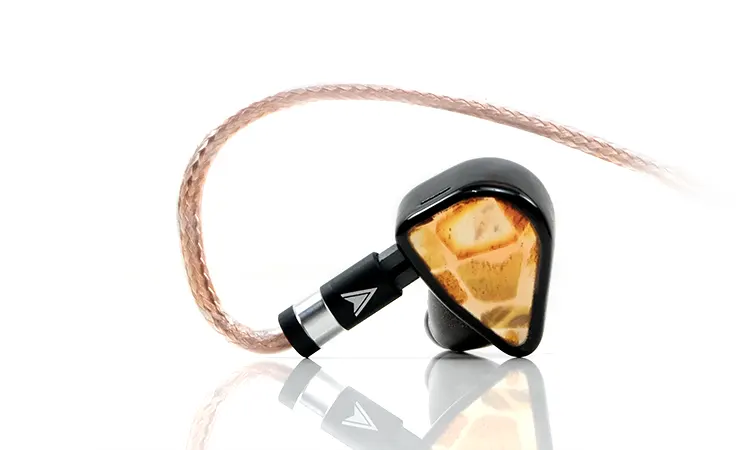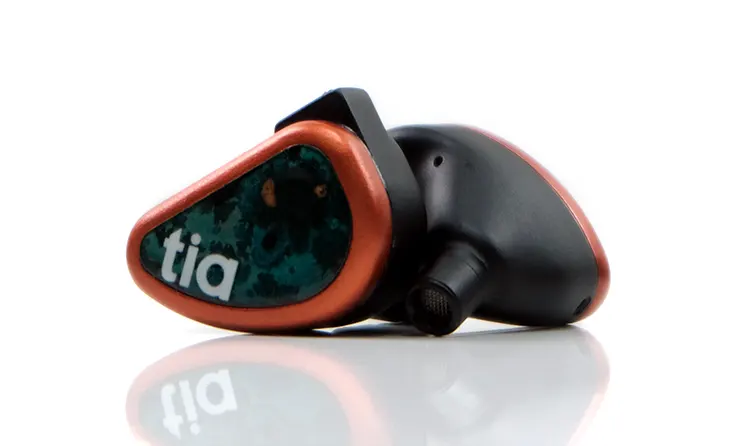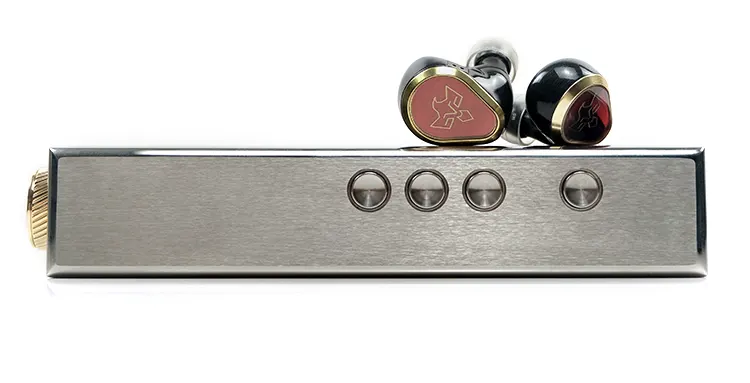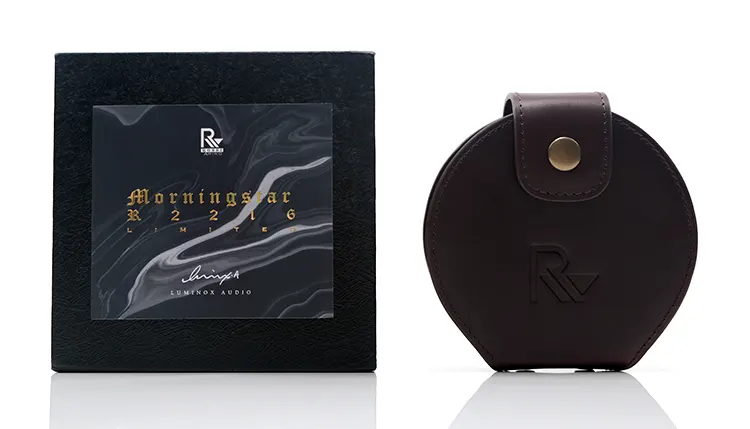Select Comparisons
The following comparisons of the Rossi&Wing First Light were completed using a mix of the iBasso DX320 MAX Ti, HiBy’s RS8, and the Cayin N8ii with the stock wide-bore silicone tips.
PMG Audio Apx
The PMG Audio Apx was launched earlier this year in a limited edition format, with just 25 units released worldwide. A new Apx SE version was just released, which I will review very shortly.
Technical
Both IEMs are multi-driver models and both are tribrids with the First Light’s use of an R-ESTDD driver for the lows.
Where the Apx differs is the introduction of a rectangular Ultra planar, (UPS), alongside its 10mm PEEK dynamic driver for the sub-lows and a custom round Ultra planar tweeter for the highs above 10k.
Both IEMs use dual BA arrays with the Apx configured with 4 for the lower-mids, mids, mids/lower-highs, and highs, an equivalent of 8 unique BA drivers.
The First Light has 6 dual BA driver arrays for the mids and highs so technically 4 additional BA drivers to cover a similar range though its BA and not planar for the ultra-highs.
The Apx has an impedance rating of 5Ω ±1Ω and a middling sensitivity level for an IEM at 107dB @1kHz 1mW so slightly less load but not quite as efficient as the First Light’s 13.5Ω and 113 dB/mW @ 1 kHz rating.
Given that PMG Audio is the brainchild of Custom Audio, the Apx also uses FIBAE technology for flat impedance.
Quite how much of an influence that has on the performance of the Apx will largely depend on the output impedance of a DAP or amplifier. There are still some high-impedance offerings out there such as the ONIX Mystic XP1.
Design
The Apx is by far the smaller and shallower of the two IEMs. Design, however, I might give the edge to the First Light’s 3-dimensional plating and gold underlay.
I get a nice warm ambiance from the Apx with its striking amber plate but it is relatively 2-dimensional. Both shells beneath the plates are more functional than shooting for the wow factor.
The Apx is much narrower, with more of an emphasis on depth of insertion whereas First Light makes a stronger play for tip compatibility. As such, the Apx will look (and feel) more discreet when inserted into your ear.
The contouring on both main shells is a bit truncated. It is not as aggressive as some universal resin shells but there is a degree of contouring to elicit a secure fit from both.
I give the Apx an edge in comfort simply because of how small and lighter the shells are but I find isolation to marginally favor First Light.
Not by much, it’s more of a better external noise low-frequency cancellation than high-frequency when using the stock tips. You do have to fiddle with the depth of insertion with the First light to get that performance level whereas the Apx works right away.
No question the First Light Luminox Morningstar cable is a class up from the Apx’s stock Omega in terms of looks. You could argue the coaxial geometry is more complex but since both are 4-wire there shouldn’t be a huge difference in impedance.
One advantage of the Omega is the interchangeable plug system. The Morningstar’s 4.4mm plug is fixed with no other choices reducing connection flexibility unless you have adaptors.
Performance
These are two very different-sounding monitors. In a way, the First Light is how I might envision the Apx sounding if I flipped their response curves.
The Apx is much cleaner sounding and brighter on the highs but also more spacious and open sounding through the mids with wider staging width and stronger channel separation.
The First Light is denser and weightier on the lows with enhanced bloom through the upper bass and lower mids. It is more rounded and even-harmonic sounding with relaxed upper mids and treble tuning.
It has a narrower X-axis for staging compared to the Apx, and slightly less channel separation through the mids but sounds firmer and deeper on the Y-axis.
How you choose between these two will come down to your tonal preference and how much you value your ‘chiseled’ definition on higher-pitching notes.
I do think that the Apx is stronger on the technical side as a result of its more pronounced upper-mids and treble tuning giving its upper register notes performance more contrast and perceived impact.
First Light has a dip in the corresponding areas from around 3-4k upwards so there is less air and more warmth. The vocal note is denser, more even-harmonic, and will sound comparatively muted without PEQ.
However, it is also less likely to jar with reduced sibilance which the Apx can be prone to producing so if you are sensitive to sharper treble the PMG Audio tuning might not be the right choice for you.
64 Audio Fourte
The 64 Audio Fourte was released around 8 years ago and is still the company’s flagship universal IEM. Surprisingly, for one reason or another, I have never reviewed it.
Only recently did I acquire a sample for listening purposes so it will start to come up in more review comparisons beginning with this one.
Technical
The Fourte is ‘just’ a hybrid 4-driver universal monitor, which is the understatement of the year, or any year for that matter.
In many ways, the Fourte was a ground-breaking IEM in 2016 and 2017 for introducing the tubeless acoustic designs, tia drivers, and pressure balancing systems (then ADEL now apex).
The driver configuration is unchanged with a tia High Driver, a High-Mid Driver, a tia Mid Driver, and a similar sized 10mm dynamic driver for the lows though it is not as complex as the 10mm R-ESTDD inside First Light.
I am pretty sure First Light’s dual BA array is tubed for phase and timing along with its large resonance chamber to create that bigger shell size. One thing to note with the Fourte is the internal apex pressure system which is similar to the Trio but the damping is heavier at -20 dB as opposed to -15 dB.
That gives you the maximum isolation possible for an apex-equipped 64 Audio IEM but even so, it’s not quite the same as a regular non-vented all-BA IEM for pure isolation performance.
The Fourte is rated at 10Ω impedance with an SPL of 114 dB/mW @1kHz so quite close to the First Light’s 13.5Ω and 113 dB/mW @ 1 kHz rating. My real-world testing with the iBasso DX320 MAX Ti on a 4.4mm balanced stage 4 gain setting has the First Light more sensitive by 2 clicks.
Design
The Fourte, like the Apx, is dwarfed by the size of the First Light. Not that the First Light is a huge IEM per se but rather the Fourte tubeless 4 driver config allows 64 Audio to produce a very compact and light design.
The Fourte aesthetics, however, is showing its age a little. It was great for 2017 but 64 Audio have classier more complex plates now on offer for their newer universals.
I would say good overall but not quite as attractive and unique was the lattice type cut and underlying gold tones of the First Light faceplates.
The First Light main shell has a more accurate 3D contouring on its resin finish but the nozzle and body are much thicker when compared to the Fourte form factor.
The smaller shell of the Fourte makes for a comfier, flusher fit inside my ear, however, when using silicone tips on both the passive isolation levels are not that different. Only when you switch to the Fourte stock tips do I get a superior level of passive isolation.
The Fourte comes with 64 Audio’s black ‘Premium cable’ which is terminated with a 3.5mm single-ended jack by default. Time for a refresh from 64 Audio? I could do with this being 4.4mm balanced at this level similar to First Light’s Morningstar stock cable.
The finish is just ok, the gauge is more or less the same at 26AWG, and it is a good quality 4-wire SPC inside. It handles well but lacks the eye candy of the First Light Morningstar cable or the functionality of the module system from the Apx Omega cable.
Performance
As with the Apx, the Fourte has a noticeably more pronounced 5-10k region but behind the mids is a substantial 800hz-2k dip. That gives it a brighter leaner tone, one with more headroom, air, and sparkle compared to First Light but also less body and sustain in midrange timbre.
The First Light has a noticeably thicker timbre, more warmth, and less of a dip in the lower-mids ensuring underlying lower register instrumental presence is heard and at times felt.
I would argue that the ethereal quality, slightly stronger dynamic range, and higher contrast tuning of the Fourte create a better foundation for picking out delicate spatial cues and can sound more detail-orientated.
The First Light’s focus is on creating a more coherent and pleasing tonal quality, one I find a bit more consistent throughout the range but darker up top.
The dynamic driver bass on the Fourte is somewhat detached from the rest of the frequency response. It does have more of a U-shaped curve creating a stronger perception of a bass-to-midrange separation in the presentation.
It can sound deeper than the First Light and there is a definite sub-bass bias depending on the tip choice. However, it is not as detailed or integral to the presentation with that lower-mid dip cutting out some presence leading into the mids.
I did say bright, the Fourte is sparkling compared to the First Light. Unlike the Apx it doesn’t seep into the mids in terms of overt sibilance so the note quality is lean but relatively smooth at the same time.
If you want more substance and weight to your vocal tone and do not mind losing a bit of airiness in the process the First Light is a better choice.
Vision Ears Phönix
The Vision Ears Phönix is the company’s flagship universal IEM and part of their high-end Premium Line of monitors. Launched in 2021, we reviewed it in early 2022 and it won our Top Gear Award for Best Universal IEM in the same year.
Technical
The Phönix is also an all-BA IEM as opposed to the First Lights ‘tribrid’ configuration with no less than 13 per side, 4 for the lows, 4 for the mids, 4 for the highs, and a super tweeter for the ultra-highs.
Mind you, despite not being all-BA, the First Light manages to stuff in the equivalent of 12 BA (6 dual driver arrays) though its scope is slightly narrower given its uses that 10mm R-ESTDD driver for the lows.
Vision Ears has mixed the BA types up a bit with stacked and vented dual-driver modules for the lows, non-vented for the mids that are split between the low-mids and mid/highs, and a spout-free super tweeter positioned in the nozzle.
The Phönix is rated 13Ω @ 1KHz so, while similar in load to the First Light’s 13.5Ω impedance rating it is much more sensitive at 125 dB SPL compared to 113 dB/mW @ 1 kHz.
You will notice a bit of difference in loudness with dongles and DAPs with these two IEMs. The Phönix is also more sensitive to background hiss on low volumes.
Design
Though not as compact as the Fourte or Apx, the Phonix still looks diminutive when placed beside the chunkier and slightly heavier First Light form factor.
Both aesthetics are going in a somewhat similar direction with a boutique flair in their respective craftsmanship.
The Phonix is more in the jewelry direction with a layered anodized aluminum as its base, domed sapphire glass on top of a ruby red chrome layer, and a golden Phönix logo on each side. The First Light is more noire for me, more Asian if you like, with its 3-dimensional lattice black and gold accents for its plating.
Both IEMs have a lightly contoured 3D-printed main shell though Phonix’s machined finish from dark carbon fiber mono-blocs creates a more unique effect than the plain black shells on the First Light.
The almost perpendicular-angled nozzle and flat slimline shell make the Phonix a superbly comfortable fit with excellent levels of isolation. This is an all-BA design with no venting which gives it a slight advantage over the hybrid First Light.
The Hansound-partnered Phonix stock cable has understated aesthetics and doesn’t compete with the stunning finish and external visuals of the First Light Morningstar stock cable.
However, it is packed with an excellent 4-wire silver-gold alloy with an OCC copper Litz geometry. It also has OCC copper shielding, twisted with multi-layer isolation. The cable is rated at 23AWG, higher than the Morningstar coaxial 4-wire mix of 26AWG and 25AWG materials.
Performance
These are much closer bedfellows in terms of tonal intent with both IEMs offering a smooth even-harmonic sound signature low on listener fatigue.
There are a couple of significant differences that give each a distinct sound. The first is Phonix’s all-BA low-end response producing a lighter but punchier response compared to the heavier more impactful First Light 10mm R-ESTDD driver.
The second, and still with the lows is the bloom from the mid-bass upwards which is slightly stronger on the First Light from around 200hz up to 500hz.
It creates a fuller tone on the First Light whereas the Phonix, though still relatively warm through the same region, is offset by a slightly stronger pinna gain and slightly mellower bass presence.
The third key difference and perhaps the most striking is the vocal presence. It is slightly stronger on the Phonix with a bit more treble contrast giving it a lusher and sweeter overtone.
The First Light is more analog to my ear, denser and rounded tonally with less of a treble overlay so not as sweet in its harmonic balance. It is also not quite as forward sounding in its vocal imaging though you can PEQ that to create a similar vocal first imaging experience.
Both are quite relaxed on the highs though I can detect a slightly stronger 8k peak from the Phonix which provides that additional subtle contrast on the upper mids timbre. The First Light is less so, meaning reduced sparkle in the highs.
I think both have a relatively rounded staging quality with the Phonix slightly more mid-forward whereas the First Light creates a stronger perception of weight and depth.
My Verdict
The Rossi&Wing First Light is a debut high-end IEM that confidently walks a different path from many current high-end IEMs that aim for high-contrast presentations.
It delivers a powerful, warm, and dense sound, more analog than lush in tone. A tuning with a strong focus on broad textured notes that gel beautifully with vocal acapella, bass guitar, and rhythm sections.
The Luminox cable partnership was a wise move. Not only do you get a quality-looking high-end design but it also comes with an aesthetically appealing and easy-to-manage cable.
It is not without its quirks, then again no such thing as perfect. Upper register vocals can lack a bit of air, and the tonal profile can veer to the darker side depending on the source pairing. Pairing with a clean or dynamic-sounding DAP or dongle will suit it perfectly.
The First Light Standard Edition is not due out until December 2024. The Founders Edition is almost entirely sold out right now. That is some positive feedback already from the market.
However, it is a hefty price tag so I would not recommend buying blind. I would suggest using the time until then to demo it where you can and see if this smooth-sounding flagship IEM is the right choice for you.
Rossi&Wing First Light Technical Specifications
- Driver Configuration: 10mm R-ESTDD x 1, DBAA x 6, CMB 3+1 Crossover
- Frequency Response: 20Hz – 28kHz, ± 2dB
- Sensitivity: 113 dB/mW @ 1 kHz
- Impedance: 13.5Ω @ 1 kHz






